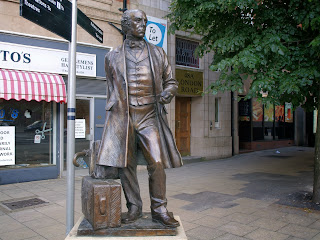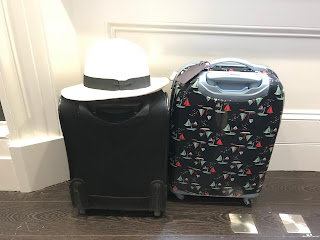Packing your bag or suitcase for train travel

Near Leicester railway station is this statue of Thomas Cook, the person who did more than anyone to promote and facilitate long-distance travel, usually by train in his day. For luggage, he is depicted with a couple of small suitcases, but how realistic this is I would not like to say. We are used to seeing in period films rich people (especially ladies!) travelling by train with copious quantities of luggage with the aid of the small armies of porters that railway companies used to provide, although Hercule Poirot always seems to manage with one small case, and Michael Portillo never has any baggage in his train travel TV programmes except in the opening sequence! (I once asked him what happens to the luggage and apparently it is taken in a van - along with other equipment needed by the production team, I presume!)
 |
| Our cases ready for our summer holiday! |
Again, we have seen people board trains with huge rigid suitcases like American refrigerators on castors: I cannot think what they carry in them! Of course, if you are going away for two or three weeks you may need a lot of stuff, and there are porterage firms (Carry My Luggage, for example) who will take your luggage on ahead like the railway companies (and British Rail, come to that) used to do as part of their service. But for one week it is easy enough to take your own luggage, with just a little thought. Easier in summer than winter because the clothes are lighter and thinner and you need fewer jumpers and coats, but you may wish to change more often. We have been away by rail in both cold and hot weather and have never struggled with our luggage, even though one of us never travels without comprehensive photography equipment including a computer!
 One key is not to take things that are provided by the hotels or B&B where you are staying: hair-dryers, soap, shampoo, shower gel, towels etc are quite unnecessary these days. Take small sizes of things you do need, rather than the large "economy" sizes of toothpaste etc. Boots sells travel-sized tubes of toothpaste in a section with other travel goods, not with the toothpastes, and if you are starting with the sleeper trains to Scotland (First Class) or Cornwall the comfort pack includes toothpaste in an even tinier tube. I kept the case from my Caledonian Sleepers comfort pack together with the toothbrush that packs into its own handle and all the other useful stuff it contains. By removing the bedsocks (!) which I did not find necessary there is room for a small stick deodorant and aftershave - I decant aftershave into a tiny spray bottle which I got from a Christmas cracker, but I think you can buy them in chemists. I manage without the electric toothbrush while I am travelling. When the packable-up toothbrush finally wore out, I was able to buy a replacement (Wisdom brand) in Savers.
One key is not to take things that are provided by the hotels or B&B where you are staying: hair-dryers, soap, shampoo, shower gel, towels etc are quite unnecessary these days. Take small sizes of things you do need, rather than the large "economy" sizes of toothpaste etc. Boots sells travel-sized tubes of toothpaste in a section with other travel goods, not with the toothpastes, and if you are starting with the sleeper trains to Scotland (First Class) or Cornwall the comfort pack includes toothpaste in an even tinier tube. I kept the case from my Caledonian Sleepers comfort pack together with the toothbrush that packs into its own handle and all the other useful stuff it contains. By removing the bedsocks (!) which I did not find necessary there is room for a small stick deodorant and aftershave - I decant aftershave into a tiny spray bottle which I got from a Christmas cracker, but I think you can buy them in chemists. I manage without the electric toothbrush while I am travelling. When the packable-up toothbrush finally wore out, I was able to buy a replacement (Wisdom brand) in Savers. |
| My case and backpack on the right, Alison's stackable cases on the left |
All the clothes together with the aforesaid Caledonian Sleeper toilet case go into a modest-sized wheeled suitcase with retractable handle so that it can conveniently be carried where necessary. We have expandable cases so that we can cope with longer trips and/or thick winter clothing. We also each have a smaller case which can be fitted to the extended handle of the wheelie case if we really need lots of space! We tend to wear for travelling the smartest outfits we are taking, so that they do not become creased in the suitcase; it's always nice to dress up a bit when travelling First Class anyway, as we tend to do on long trips if we can book far enough in advance. Another trick is to be reasonably monochrome in the clothes we take, so that we can mix and match easily: I took three black shirts to Edinburgh with black jeans and smart black trousers, jacket and warm jumper and my grey Berghaus jacket! Sometimes I take brown instead of black, or grey, and in summer can be slightly more adventurous ...
Our cases also have outside zip pockets which take items like books and magazines to read on the train journey. Duly packed, with travel tickets, passports etc handy in zipped jacket pockets we are ready to leave for the railway station. With cases stacked and with a backpack, one hand is always free for opening doors and gates, showing tickets etc (or carrying an umbrella).
Luggage facilities on trains vary widely. Almost all modern trains have racks at the ends of each coach, but these can sometimes be some way from where we are sitting and therefore difficult to keep watch over - and inconvenient if something is needed. Many trains also have some space between seat backs, although back-to-back seating is becoming less common. All have overhead racks and if cases are kept small and light enough this is usually the best option, although on Voyager trains used on some CrossCountry and Virgin Trains (West Coast Main Line) services the overhead racks will take nothing bigger than a briefcase, so the other options are essential. It is bad manners to place luggage on seats which others may need if the train becomes busy, and if the aisle is blocked this will prevent the refreshment trolley getting through!
Once checked-in at a hotel for a stay, the luggage obviously stays there and no longer has to be lugged, but on some trips we visit places en-route before checking in or after checking out, and provision has to be made then. So far we have had no problems; hotels have always been happy to store our luggage before check-in and/or after check-out. These days in Britain only a few major railway stations have left luggage facilities: the days when almost all of them had cheap-to-use self-service lockers are gone, largely because of security considerations, and now staff check the baggage and store it carefully for passengers, which costs money and is not viable except at busy places. We left our bags at Aberdeen station on our Scottish trip last year, but that is, I think, the only time. There are more left luggage facilities at continental railway stations. On other occasions we find that we can leave our things at the venue we are visiting: many museums etc have cloakrooms or self-service lockers which will also take cases, National Trust properties usually have lockers, or desk staff will look after things on request. If in doubt we check when devising the itinerary, and our hotels and B&Bs have always, when asked, let us leave our luggage before check-in or keep it for us after check-out. We have never struggled to find somewhere to leave our cases.
 |
| That's luggage for two of us for a continental trip in winter. The people just boarding clearly do not travel the way we do. |
mwtrips travelwear shop
In my shop on this website is a selection of bags suitable for days out and for short stays, so do have a look at that if you want something a bit different and that celebrates travel by train!
clothes and accessories for the traveller




What takes travel backpacks miles ahead of the traditional backpack is the daypack added to them. small travel backpack
ReplyDeleteCarry on luggage with wheels is well suited for use on any type of travel. lightweight carry on luggage
ReplyDeleteSome interesting suggestions among those reviews, although I have to say I do not know any of the brands!
Delete